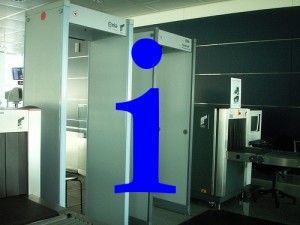False Sense of Security: Part II

I recently posted about a fun experience with the metal detectors and security staff at the Oakland WCAB. ((Original photo courtesy of Daquella manera.))
At the end of January I was fortunate enough to witness more security shenanigans.
A man in line behind me took off all metal from his person and placed it in the provided gray plastic bin. Here’s a summary of the exchange between this gentleman and the security guard:
- Security: Sir, you’re going to have to take off your belt.
- Man: My belt buckle is metal. I took it off, see? There’s no metal in my belt.
- Security: That doesn’t matter, sir. Please take off your belt.
- Man: But, there’s no metal in it.
- Security: Sir, you’re going to need to put your belt through the metal detector.
- The man finally took off his belt…
I have several problems with this ((imaginary)) “security procedure.”
- It is irrational and absurd.
- This system encourages security guards to be lazy and unobservant, encouraging the hiring of unsophisticated or untrained security guards.
- This system places too much importance on the value of x-ray machines.
Let’s take this point by point, shall we?
First, when challenged to provide any rationale for their demands, the security staff resorts to argumentum ad verecundiam. ((Latin argument for “appeal to authority” aka “I have a badge so I must be right” aka “‘Cause I said so, that’s why.”)) There’s no reason why a non-metal belt buckle or, heaven forbid a piece of paper, needs to be fed into the x-ray machine. They’re not security risks.
Second, the current system allows the security guards to insist all detachable belongings be fed into the x-ray machine. ((Don’t forget to put your right to privacy in that bin. After all, you don’t have anything to hide from Big Brother, do you?)) ((For a while they actually required the removal of shoes too. Taking your shoes off at the airport is bad enough. But at the Oakland state building???)) The current system essentially removes the incentive for hiring trained, competent, or intelligent staff. And, really, why should they? A mannequin with a sign around its neck could instruct everyone to remove all belongings.
Finally, the current system allows all the security guards at the Oakland state building to place too much importance on the x-ray machines. Once you’ve placed your belongings ((And dignity! Don’t forget your dignity! Don’t worry, after a couple of times through this system it will be small enough to fit comfortably between your cell phone and belt buckle.)) in the plastic bin, you aren’t given a second glance. What happens if someone decides to conceal a dangerous non-metalic object on their person? These security guards believe that paper should be x-rayed! I’m supposed to trust in their powers of keen observation?
Can you tell I’m frustrated with the security situation at the Oakland WCAB?


